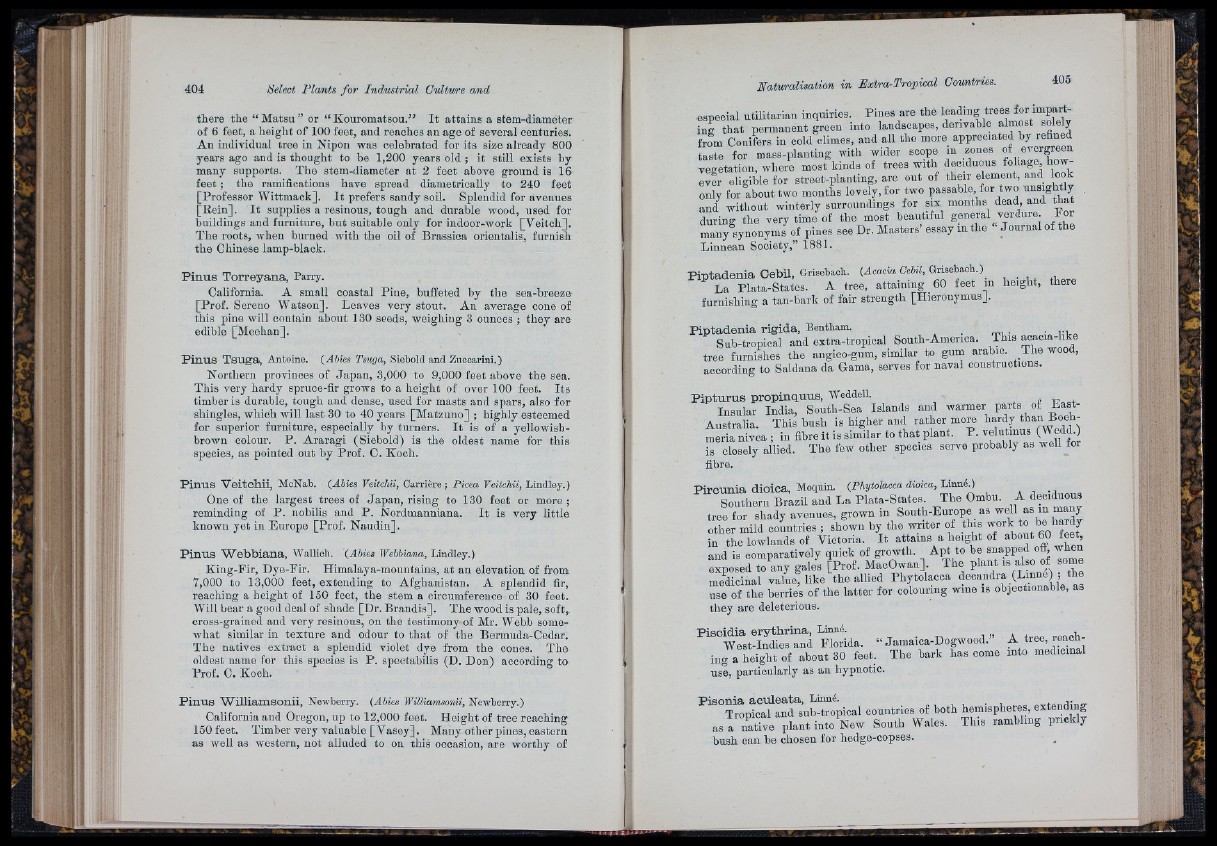
there the “ Matsu ” or “ Kouromatsou.” I t attains a stem-diameter'
of 6 feet, a height of 100 feet, and reaches an age of several centuries.
An individual tree in Nipon was celebrated for its size already 800
years ago and is thought to be 1,200 years old ; it still exists by
many supports. The stem-diameter at 2 feet above ground is 16
feet ; the ramifications have spread diametrically to 240 feet
[Professor Wittmack]. I t prefers sandy soil. Splendid for avenues
[Rein]. I t supplies a resinous, tough and durable wood, used for
buildings and furniture, but suitable only for indoor-work [Veitch].
The roots, when burned with the oil of Brassica orientalis, furnis
the Chinese lamp-black.
P in u s T o rre y a n a , Parry.
California. A small coastal Pine, buffeted by the sea-breeze
[Prof. Sereno Watson]. Leaves very stout. An average cone of
this pine will contain about 130 seeds, weighing 3 ounces ; they are
edible [Meehan].
P in u s T su g a , Antoine. {Abies Tsuga, Siebold and Zuccarini. )
Northern provinces of Japan, 3,000 to 9,000 feet above the sea.
This very hardy spruoe-fir grows to a height of over 100 feet. Its
timber is durable, tough and dense, used for masts and spars, also for
shingles, which will last 30 to 40 years [Matzuno] ; highly esteemed
for superior furniture, especially by turners. I t is of a yellowish-
brown colour. P. Araragi (Siebold) is the oldest name for this
species, as pointed out by Prof. C. Koch.
P in u s V e itc h ii, McNab. {Abies Veitchii, Carrière; Picea Veitchii, Lindley.)
Cne of the largest trees of Japan, rising to 130 feet or more ;
reminding of P . nobilis and P . Nordmanniana. I t is very little
known yet iu Europe [Prof. Naudin].
P in u s "Webbiana, Wallich. '{Abies Webbiana, Lindley.)
King-Fir, Dye-Fir. Himalaya-mountains, at an elevation of from
7,000 to 13,000 feet, extending to Afghanistan. A splendid fir,
reaching a height of 150 feet, the stem a circumference of 30 feet.
Will bear a good deal of shade [Dr. Brandis]. The wood is pale, soft,,
cross-grained and very resinous, on the testimony of Mr. Webb somewhat
similar in texture and odour to th a t of the Bermuda-Cedar.
The natives extract a splendid violet dye from the cones. The
oldest name for this species is P. speotabilis (D. Don) accordine to
Prof. C. Koch.
P in u s W illiam so n ii, Newberry. (Abies Williamsonii, Newberry.)
California and Cregon, up to 12,000 feet. Height of tree reaching
150 feet. Timber very valuable [Vasey]. Many other pines, eastern
as well as western, not alluded to on this occasion, are worthy of
especial utilitarian inquiries. Pines are the leading trees foL m p a rt-
ing th a t permanent green into landscapes, derivable almost solely
f r L Conifers in cold climes, and all the more appreciated by refined
taste for mass-planting with wider scope in zones of eveigreen
vegetation, where most kinds of trees with decMuous foliage, however
eligible for street-planting, are out of their element, and look
only for about two months lovely, for two passable, for two unsightly
and without winterly surroundings for six months dead and th a t
during the very time of the most heautiful general verdure. For
many synonyms of pines see Dr. Masters’ essay in the Journal of the
Linnean Society,” 1881.
P ip ta d e n ia Cebil, Grisebach, (Acacia GeUl, Grisebach.)_
La Plata-States. A tree, attaining _ 60 feet in height, there
furnishing a tan-bark of fair strength [Hieronymus].
P ip ta d e n ia rig id a , Bentham. ,
Sub-tropical and extra-tropioal South-Amerioa. This acacia-like
tree furnishes the angioo-gum, similar to gum arabic. The wood,
aecording to Saldana da Gama, serves for naval constructions.
P ip tu r u s p ro p in q u u s , Weddell. .
Insular India, Sonth-Sea Islands and warmer of East-
Anstralia. This bush is higher and rather more hardy than Boehmeria
nivea ; in fibre it is similar to th a t plant. P . vdutmus (Wedd )
is closely allied. The few other species serve probably as well lor
fibre.
P ir c n n ia dio ic a , Moquin. {PhytoUcca dioiea, LinnéJ
Southern Brazil and La Plata-States. The Cmbu. A deciduous
t r e e for s h a d y a v e n u e s , g row n in S o u th -E u ro p e a s w e ll a s in m an y
other mild countries ; shown by the wnter of this to be hardy
in the lowlands of Victoria. I t attains a height of about 60 feet
and is comparatively quick of growth. Apt to be snapped off when
exposed to any gales [Prof. MacOwan]. The plant is airo of some
medicinal value, like the allied Phytolacca decandra (Lmne) ; the
use of the berries of the latter for colouring wine is objectionable, as
they are deleterious.
P is o id ia e ry th r in a , Linné. , „ . , n
West-Indies and Florida. “ Jamaica-Dogwood.
ing a height of about 30 feet. The bark has come into medioinal
use, particularly as an hypnotic.
P is o n ia a c u le a ta , Linné. . »• „
Tropical and sub-tropical countries of both hemispheres, extending
as a native plant into New South Wales. This rambling prickly
hush can be chosen for hedge-copses.